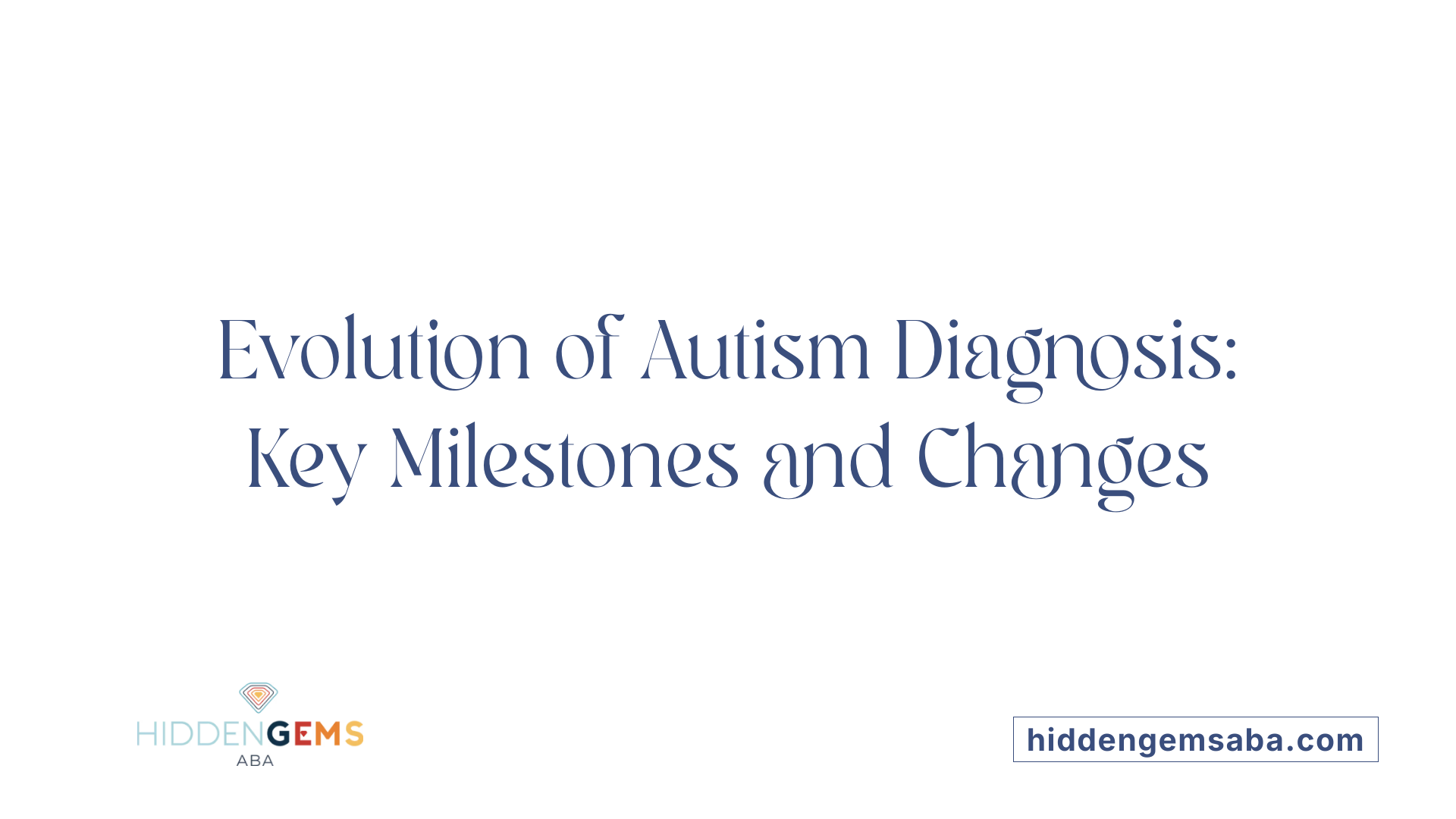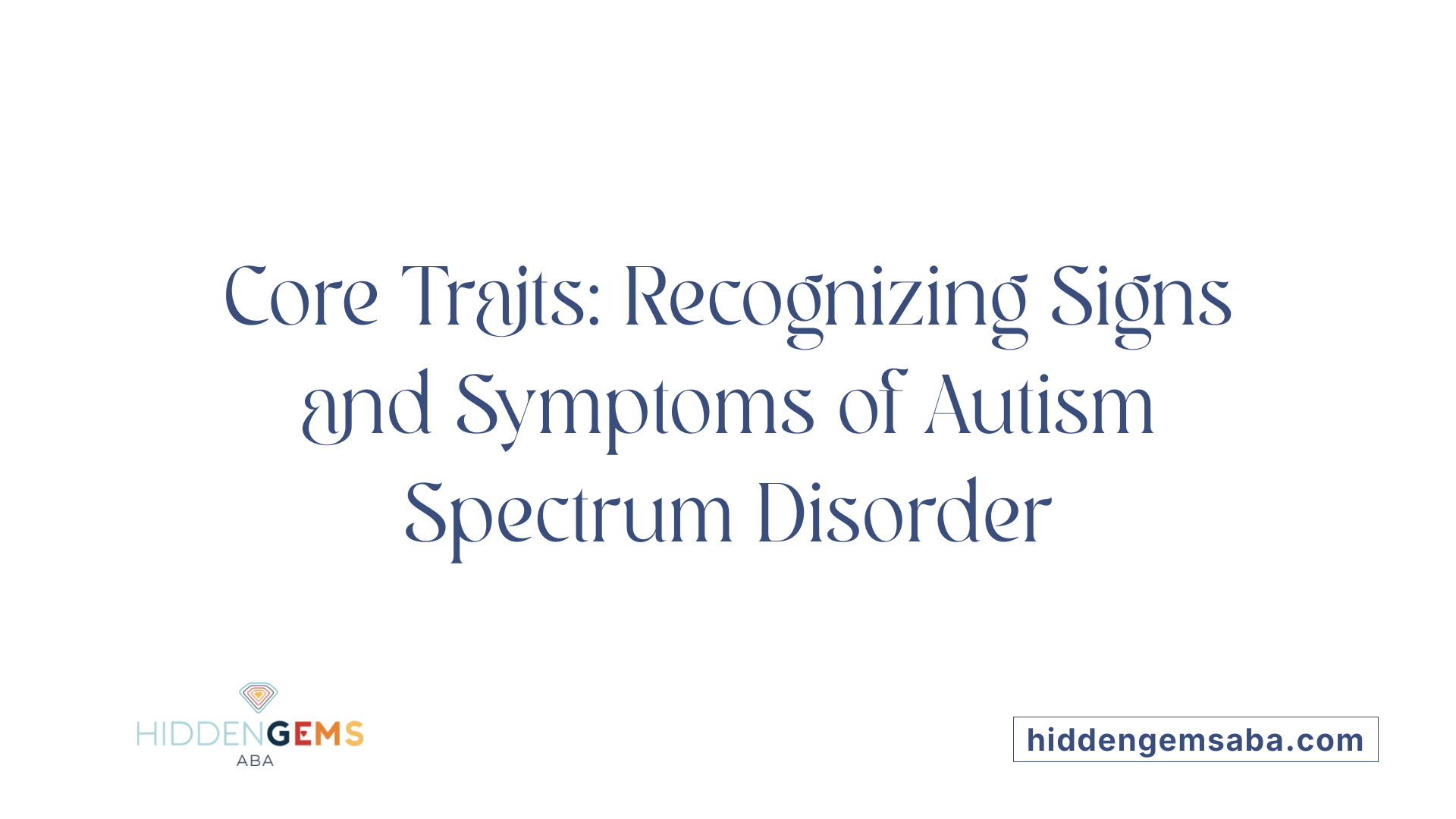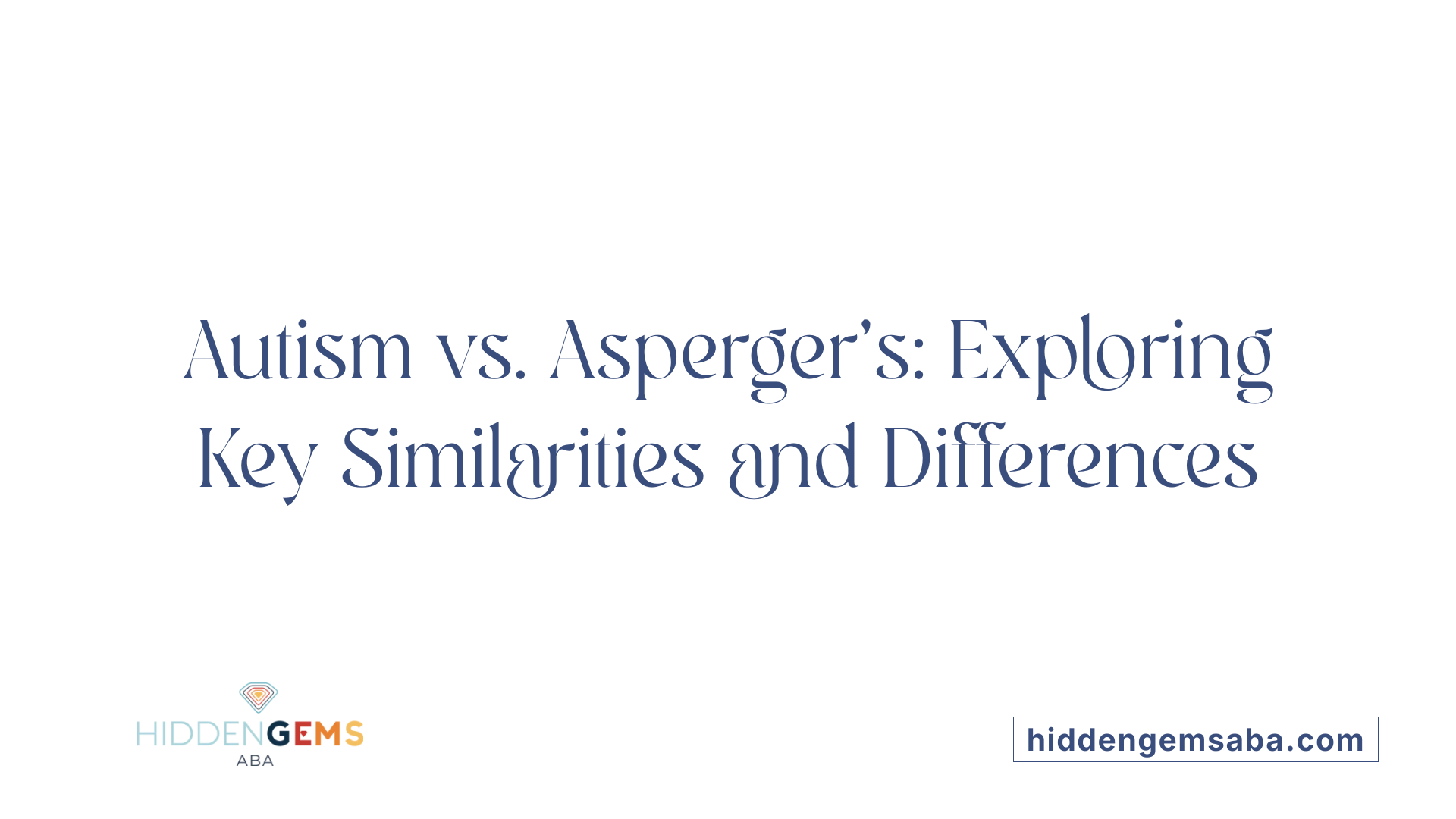Understanding the Complex Landscape of Autism Spectrum Disorders
The question of whether autism and Asperger's syndrome are the same or different conditions has evolved significantly over time. Historically viewed as separate diagnoses, today's diagnostic frameworks recognize them as part of a broad spectrum. This article explores the history, definitions, symptoms, and current classifications to clarify their relationship and the cultural implications of terminology.
Historical Context and Evolving Diagnostic Classifications

How has the terminology and classification of autism spectrum disorders evolved over time?
Initially, autism was considered a separate and distinct mental health condition, identified by specific symptoms such as social difficulties, communication challenges, and repetitive behaviors. The early diagnostic manuals, like DSM-III, included specific categories like autistic disorder, childhood disintegrative disorder, and PDD-NOS, positioning autism as a set of distinct developmental conditions.
In the 1990s, with the publication of DSM-IV, Asperger’s syndrome was introduced as a separate diagnosis. It described children who had typical language development and average or above-average intelligence but faced social interaction challenges and intense interests.
However, as research advanced, clinicians observed significant symptom overlap among these conditions, leading to questions about the validity of separate categories. This understanding prompted a major shift in 2013 with the release of DSM-5.
The DSM-5 merged Asperger’s syndrome, autistic disorder, PDD-NOS, and other related conditions into a single umbrella diagnosis: Autism Spectrum Disorder (ASD). This change was motivated by the need to better reflect the diversity of traits and severities within a unified spectrum. The new classification emphasizes the severity of symptoms and functional abilities rather than strict categorical labels.
Similarly, the ICD-11 (released in 2018) adopted a similar spectrum approach, consolidating previous subcategories into a single diagnosis to promote more inclusive, accurate, and less stigmatizing understanding of autism.
This evolution from distinct categories to a spectrum model reflects a more nuanced view of autism as a range of neurodevelopmental conditions, allowing for more personalized assessments and interventions. It highlights individual differences, recognizing that each person experiences autism uniquely, which informs better support and understanding.
| Time Period | Major Changes | Key Focus | Impact on Diagnosis |
|---|---|---|---|
| 1980s-1990s | Introduction of Asperger’s syndrome in DSM-III, DSM-IV | Separate diagnosis for high-functioning autism | Increased diagnosis of asperger’s as a distinct condition |
| 2013 | DSM-5 release | Merging all autism-related diagnoses into ASD | Simplified, spectrum-based diagnosis; reduced categorical labels |
| 2018 | ICD-11 update | Similar unification of diagnostic categories | Broad and inclusive framework for autism |
Overall, these shifts in classification have fostered a better understanding of autism’s diversity, reducing stigma and supporting a more individualized approach to intervention and support.
Core Features and Symptoms of Autism Spectrum Disorder

What are the symptoms and characteristics associated with autism spectrum disorder, including what was previously called Asperger’s syndrome?
Autism spectrum disorder (ASD) manifests through a variety of signs affecting social interaction, communication, and behavior. Individuals often experience difficulties with eye contact, understanding social cues, and forming relationships, which impacts social engagement. Repetitive actions, such as hand-flapping, rocking, or lining up objects, are common behaviors, along with intense or narrow interests that may dominate their attention.
Sensory sensitivities, like overreacting or underreacting to sounds, lights, or textures, are also frequently observed. The range of cognitive abilities among those with ASD varies widely—from individuals with intellectual disabilities to those with average or above-average intelligence. Symptoms generally appear early in childhood, often by age 2 or 3, although signs can sometimes be noticed earlier or later.
Before the DSM-5 introduced a spectrum concept in 2013, Asperger’s syndrome was recognized as a milder form of autism. It was characterized by normal language development, average to above-average intelligence, and social difficulties such as awkwardness or difficulty reading social situations. These individuals often had focused interests or hobbies and might have been perceived as socially odd but cognitively typical.
With the reclassification in 2013, Asperger’s syndrome was incorporated into the broader ASD diagnosis, now labeled as level 1 autism. This change emphasizes the diversity of experiences and symptom severity. Many individuals with what was formerly called Asperger's continue to identify with that term personally, especially those who have fewer support needs. Overall, ASD is a varied condition, with core features like social deficits and repetitive behaviors present in different combinations and intensities across individuals.
Difference and Similarities Between Autism and Asperger's

What are the key differences and similarities between autism and Asperger's syndrome?
Autism spectrum disorder (ASD) and Asperger's syndrome share several foundational features. Both conditions involve challenges with social interactions, communication difficulties, and restricted or repetitive behaviors. Historically, Asperger's syndrome was viewed as a milder form of autism, primarily because individuals with Asperger’s typically have normal or above-average intelligence and do not experience language delays.
The main distinctions previously centered on severity and language development. Children with autism often have delayed speech, difficulties understanding social cues, and may have cognitive impairments. Conversely, those diagnosed with Asperger's usually develop language skills on schedule, perform well academically, and possess average or superior intelligence.
In recent diagnostic frameworks, particularly DSM-5 (2013) and ICD-11 (2019), Asperger's syndrome is no longer used as a formal diagnosis. Instead, both are grouped under autism spectrum disorder, recognizing a continuum of neurodevelopmental differences. This move emphasizes that autism is highly diverse, with severity and skills varying widely among individuals.
Genetic factors appear significant for both conditions, although exact causes are still being researched. Environmental influences such as parental age and prenatal factors may also contribute, but there is no evidence linking vaccines to autism.
In terms of functioning, people with Asperger’s generally require less support and can often live independently, whereas those with more severe autism may need extensive assistance. Despite the shift in terminology, many individuals who previously identified with Asperger’s continue to do so for personal or cultural reasons.
Overall, understanding these conditions as part of a spectrum helps destigmatize autism, celebrating the diversity of cognitive, social, and behavioral profiles within this neurodiverse community.
Personal Perspectives and Current Usage of Terminology
Can someone diagnosed with Asperger's syndrome call themselves autistic today?
Yes, someone diagnosed with Asperger’s syndrome can now refer to themselves as autistic. The reason is that Asperger’s was officially reclassified in 2013 with the publication of DSM-5, which integrated it into the broader diagnosis of autism spectrum disorder (ASD). This change means there is no longer a separate diagnosis for Asperger’s, but rather it is included under the umbrella of ASD.
Individuals previously diagnosed with Asperger’s often fall under what is now called 'level-one autism'—a category that typically indicates fewer support needs. These individuals usually have average or above-average intelligence and do not experience significant delays in language development. Despite the change in terminology, many still identify with the term 'Asperger’s' because it reflects their personal experience and identity.
Since ASD encompasses a wide variety of characteristics and severities, using the term 'autistic' accurately describes a broad spectrum of neurodevelopmental differences, including those once classified as Asperger’s. Therefore, adopting the term 'autistic' aligns with contemporary understanding and promotes inclusive, respectful communication about diverse neurological profiles.
Overall, reclassification aims to reduce stigma and better reflect the varied experiences of people on the spectrum. Whether someone prefers to identify as autistic or with the term Asperger’s depends on personal preference, but both are valid within the current framework of autism spectrum disorder.
Implications of Classification and Societal Perspectives
What does it mean to have 'high-functioning autism' in relation to Asperger's syndrome?
The term 'high-functioning autism' typically describes individuals on the autism spectrum with average or above-average intelligence and relatively intact language skills. This description often overlaps with what was previously known as Asperger's syndrome, a diagnosis characterized by difficulties in social interaction, understanding social cues, and maintaining interests, but without significant delays in speech or cognition.
Historically, Asperger’s syndrome was identified in the 1940s by Hans Asperger, who noted children with these traits but normal cognitive and language development. Between ages four and eleven, children diagnosed with Asperger's often show typical language skills and cognitive ability, which can persist into adulthood.
In recent years, diagnostic manuals like DSM-5 and ICD-11 have eliminated Asperger’s as a separate diagnosis, instead including these individuals within the broader autism spectrum disorder (ASD). This reflects a nuanced understanding that autism presents along a spectrum of symptoms and abilities, rather than distinct categories.
People previously diagnosed with Asperger’s generally face social and behavioral challenges, such as difficulties in social communication and understanding social cues. However, they tend to perform well academically and professionally, leveraging their strengths in areas like math, science, or detailed interests.
Interventions targeted at this group often focus on enhancing social skills, managing co-occurring conditions like anxiety or ADHD, and fostering effective communication. Recognizing the diversity within autism helps reduce stigma and promotes acceptance, emphasizing that each individual has unique strengths and challenges.
Looking Ahead: Embracing Diversity on the Spectrum
The understanding of autism and Asperger's has advanced significantly, moving from rigid categories to a nuanced spectrum that highlights individual differences. While terminology continues to evolve, the focus remains on supporting people's unique needs, fostering inclusion, and dispelling myths. Recognizing the shared core features and distinctions helps promote awareness, acceptance, and tailored interventions, ultimately enriching the lives of those on the autism spectrum.
References
- Asperger's vs. Autism: What's the Difference?
- Asperger syndrome (Asperger's) - National Autistic Society
- What is the difference between Asperger's syndrome and autism?
- Difference Between Autism and Aspergers Syndrome
- Asperger's Syndrome - Nationwide Children's Hospital
- Asperger syndrome | Autism Speaks
- What is the difference between autism and Asperger's?
- What is autism? - NHS



.jpg)

